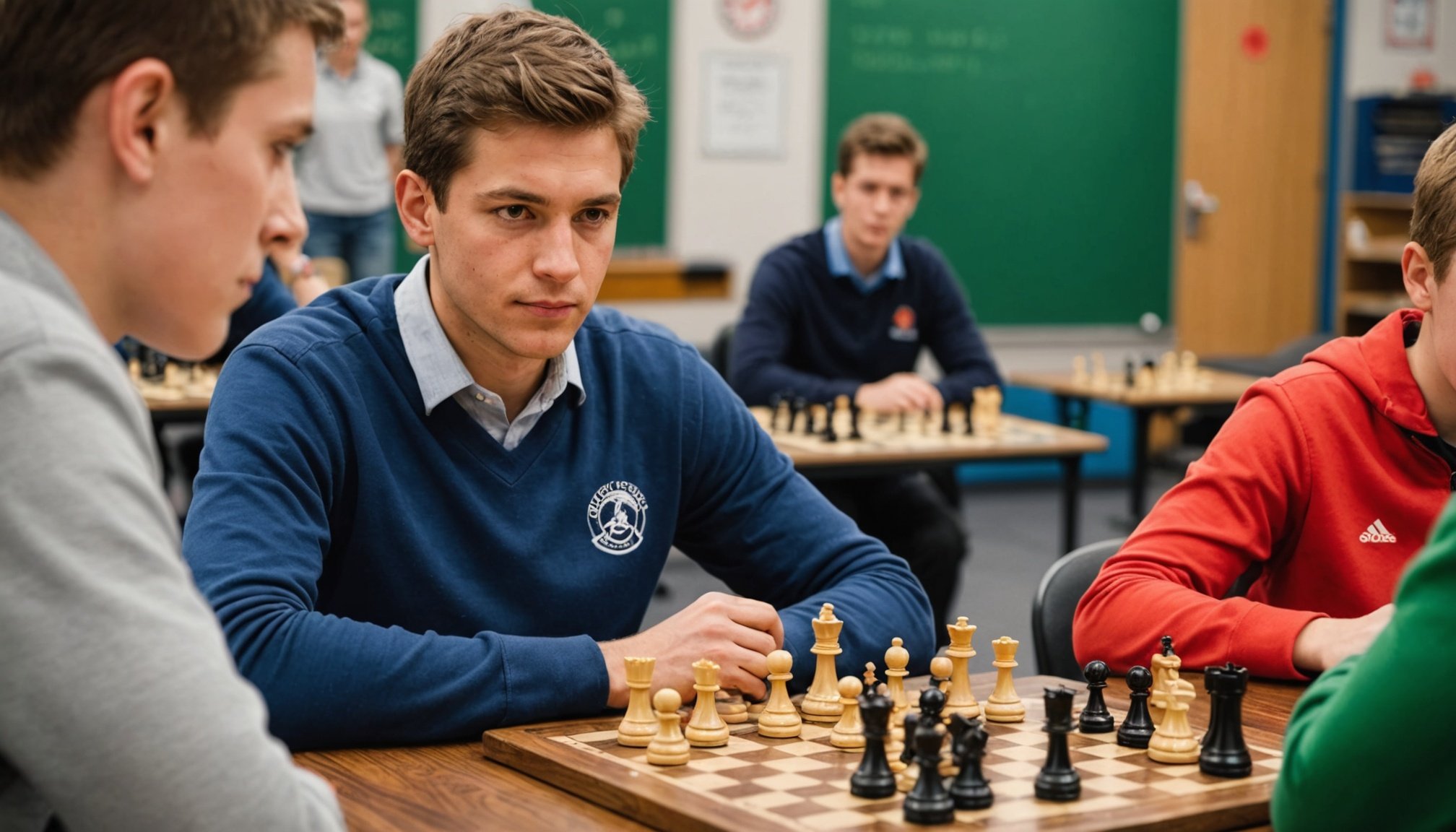Unlocking Success: The Ultimate Guide to Teaching Strategic Decision-Making Skills to Chess Players in Sports Schools to Strategic Decision-Making in Chess
Chess, often referred to as the “game of kings,” is more than just a hobby or a competitive sport; it is a powerful tool for developing strategic decision-making skills. These skills are not only crucial for excelling in the game but also translate well into various aspects of life, making chess an invaluable addition to any sports school curriculum. In this guide, we will explore how to teach strategic decision-making skills to chess players, and why this is so important.
The Cognitive Benefits of Playing Chess
Playing chess has been widely recognized for its cognitive benefits, particularly in enhancing critical thinking, problem-solving, and analytical skills. Here are some key cognitive benefits that make chess an excellent activity for kids and adults alike:
Also read : The Impact of Hydration on Mental Performance in Long-Distance Running: Unveiling the Connection
- Improved Critical Thinking: Chess requires players to evaluate positions, anticipate moves, and make informed decisions. This process enhances critical thinking by forcing players to consider multiple scenarios and outcomes.
- Enhanced Problem-Solving Skills: Each chess game presents a unique set of problems to solve. Players must think creatively and logically to overcome these challenges, which improves their overall problem-solving abilities.
- Boosted Memory and Concentration: Remembering moves, strategies, and openings requires strong memory and concentration. Regular chess play can significantly improve these cognitive functions.
- Developed Analytical Skills: Analyzing positions, moves, and strategies is a core part of playing chess. This analytical thinking can be applied to various real-life situations.
Integrating Chess into Sports Schools
Integrating chess into sports schools can be a win-win for both the students and the institution. Here’s how you can do it effectively:
Creating a Chess Program
To start a chess program, you need a clear plan and the right resources. Here are some steps to consider:
Also to read : Find local pick up soccer games in new york city today
- Hire a Chess Coach: A professional chess coach can provide structured lessons and guidance. Look for coaches with experience in teaching kids.
- Use Online Resources: Utilize online platforms like ChessBase, which offer a wealth of chess lessons, videos, and interactive tools. An account with ChessBase can be a valuable resource for both teachers and students.
- Form Chess Classes: Organize regular chess classes as part of the school curriculum or as an extracurricular activity. Ensure classes are engaging and tailored to different skill levels.
Building a Chess Community
Creating a vibrant chess community within the school can foster a supportive and competitive environment:
- Host Tournaments: Regular tournaments can motivate students to practice and improve. These events can be held within the school or even online.
- Encourage Team Play: Team chess competitions can promote teamwork and strategic collaboration among players.
- Invite Guest Speakers: Invite professional chess players or coaches to share their experiences and insights.
Teaching Strategic Decision-Making Skills
Teaching strategic decision-making skills in chess involves several key components:
Understanding the Basics
Before diving into advanced strategies, ensure that students have a solid grasp of the game’s basics:
- Pieces and Their Movements: Understand how each piece moves and captures.
- Basic Tactics: Learn common tactics like pins, forks, and skewers.
- Check and Checkmate: Understand how to put the opponent’s king in check and checkmate.
Developing Strategic Thinking
Strategic thinking is about planning ahead and making decisions that align with long-term goals. Here are some ways to develop this skill:
- Analyze Positions: Teach students to evaluate the board, considering factors like piece development, control of the center, and pawn structure.
- Plan Ahead: Encourage students to think several moves ahead, anticipating their opponent’s responses.
- Study Chess Books and Videos: Utilize resources like chess books and online videos to learn from grandmasters and other experienced players.
Practical Tips for Teaching Strategic Decision-Making
Here are some practical tips to help you teach strategic decision-making skills effectively:
Use Real-Game Examples
Using real-game examples can make learning more engaging and relevant:
- Analyze Famous Games: Study famous games together, discussing the strategic decisions made by the players.
- Review Student Games: Go over games played by students, highlighting good decisions and areas for improvement.
Encourage Critical Thinking
Encourage students to think critically about their moves:
- Ask Questions: Ask questions like “What are your goals in this position?” or “How do you plan to achieve checkmate?”
- Promote Reflection: Encourage students to reflect on their games, identifying what went well and what could be improved.
Foster a Growth Mindset
Cultivating a growth mindset, as discussed in the context of overcoming the impostor syndrome, is crucial for continuous improvement in chess[2]:
- Embrace Mistakes: Teach students that mistakes are opportunities for learning and growth.
- Encourage Continuous Learning: Promote the idea that skills and knowledge can be developed through effort and learning.
Tools and Resources for Teaching Chess
Here are some essential tools and resources to enhance your chess teaching:
Online Platforms
- ChessBase: Offers a comprehensive database of chess games, analysis tools, and educational content. An account with ChessBase can be incredibly valuable.
- Chess.com: Provides online chess lessons, videos, and interactive tools suitable for players of all levels.
Chess Books
- “My 60 Memorable Games” by Bobby Fischer: A classic book that provides deep insights into strategic thinking.
- “How to Reassess Your Chess” by Jeremy Silman: A detailed guide to improving chess strategy and decision-making.
Chess Coaching
- Hire a Professional Coach: A coach can provide personalized feedback and guidance.
- Online Coaching Sessions: Utilize online platforms for coaching sessions, especially useful for remote learning.
Comparative Analysis of Different Teaching Methods
Here is a comparative analysis of different teaching methods to help you choose the best approach for your students:
| Teaching Method | Advantages | Disadvantages |
|---|---|---|
| Traditional Classroom | Structured learning, direct feedback from the teacher | Limited flexibility, may not cater to individual learning speeds |
| Online Chess Platforms | Flexible learning schedule, access to a wide range of resources | Requires self-motivation, potential for distractions |
| One-on-One Coaching | Personalized feedback, tailored learning plan | More expensive, limited availability |
| Group Classes | Encourages teamwork and competition, cost-effective | May not provide individualized attention |
Real-Life Examples and Success Stories
Here are some real-life examples and success stories that highlight the impact of teaching strategic decision-making skills through chess:
The Story of Viswanathan Anand
Viswanathan Anand, one of the greatest chess players of all time, attributes much of his success to the strategic thinking skills he developed through chess. Anand’s journey from a young player to a world champion is a testament to the power of strategic decision-making in both chess and life.
Chess in Schools Programs
Programs like “Chess in Schools” have shown significant improvements in students’ cognitive skills, academic performance, and overall behavior. These programs demonstrate how integrating chess into the school curriculum can have a positive impact on students’ lives. and Call to Action
Teaching strategic decision-making skills through chess is a rewarding and impactful endeavor. By integrating chess into sports schools, you can provide students with a unique set of cognitive and life skills that will benefit them far beyond the chessboard.
Key Takeaways
- Cognitive Benefits: Chess enhances critical thinking, problem-solving, and analytical skills.
- Strategic Thinking: Teach students to analyze positions, plan ahead, and make informed decisions.
- Resources: Utilize online platforms, chess books, and professional coaching to enhance learning.
- Community Building: Create a supportive and competitive chess community within the school.
Final Thoughts
As Garry Kasparov, a former world chess champion, once said, “The ability to think critically and make sound judgments is essential in all aspects of life.” By teaching strategic decision-making skills through chess, you are not just teaching a game; you are equipping your students with tools for success in all areas of life.
So, take the first move today. Introduce chess into your sports school curriculum, and watch your students grow into strategic thinkers and decision-makers who are ready to tackle any challenge that comes their way.











